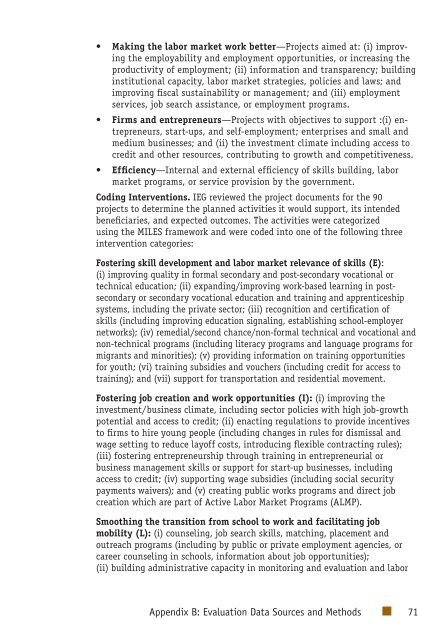Youth Employment Programs - Independent Evaluation Group
Youth Employment Programs - Independent Evaluation Group
Youth Employment Programs - Independent Evaluation Group
You also want an ePaper? Increase the reach of your titles
YUMPU automatically turns print PDFs into web optimized ePapers that Google loves.
• Making the labor market work better—Projects aimed at: (i) improvingthe employability and employment opportunities, or increasing theproductivity of employment; (ii) information and transparency; buildinginstitutional capacity, labor market strategies, policies and laws; andimproving fiscal sustainability or management; and (iii) employmentservices, job search assistance, or employment programs.• Firms and entrepreneurs—Projects with objectives to support :(i) entrepreneurs,start-ups, and self-employment; enterprises and small andmedium businesses; and (ii) the investment climate including access tocredit and other resources, contributing to growth and competitiveness.• Efficiency—Internal and external efficiency of skills building, labormarket programs, or service provision by the government.Coding Interventions. IEG reviewed the project documents for the 90projects to determine the planned activities it would support, its intendedbeneficiaries, and expected outcomes. The activities were categorizedusing the MILES framework and were coded into one of the following threeintervention categories:Fostering skill development and labor market relevance of skills (E):(i) improving quality in formal secondary and post-secondary vocational ortechnical education; (ii) expanding/improving work-based learning in postsecondaryor secondary vocational education and training and apprenticeshipsystems, including the private sector; (iii) recognition and certification ofskills (including improving education signaling, establishing school-employernetworks); (iv) remedial/second chance/non-formal technical and vocational andnon-technical programs (including literacy programs and language programs formigrants and minorities); (v) providing information on training opportunitiesfor youth; (vi) training subsidies and vouchers (including credit for access totraining); and (vii) support for transportation and residential movement.Fostering job creation and work opportunities (I): (i) improving theinvestment/business climate, including sector policies with high job-growthpotential and access to credit; (ii) enacting regulations to provide incentivesto firms to hire young people (including changes in rules for dismissal andwage setting to reduce layoff costs, introducing flexible contracting rules);(iii) fostering entrepreneurship through training in entrepreneurial orbusiness management skills or support for start-up businesses, includingaccess to credit; (iv) supporting wage subsidies (including social securitypayments waivers); and (v) creating public works programs and direct jobcreation which are part of Active Labor Market <strong>Programs</strong> (ALMP).Smoothing the transition from school to work and facilitating jobmobility (L): (i) counseling, job search skills, matching, placement andoutreach programs (including by public or private employment agencies, orcareer counseling in schools, information about job opportunities);(ii) building administrative capacity in monitoring and evaluation and laborAppendix B: <strong>Evaluation</strong> Data Sources and Methods 71
















